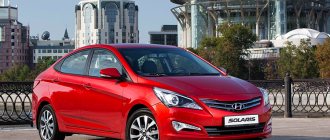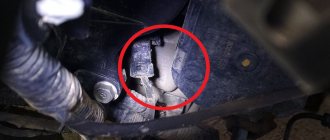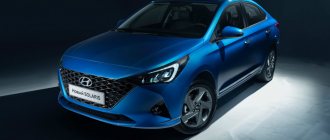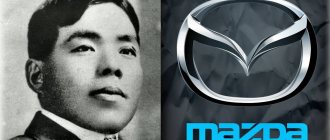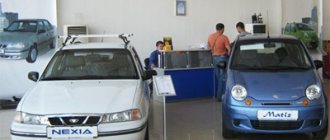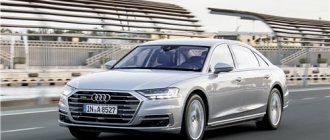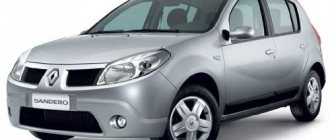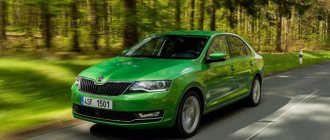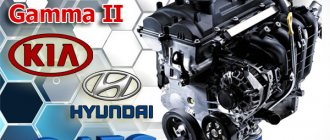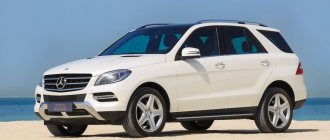Hyundai Solaris is a very popular car in our market. It was introduced in Russia in September 2010, and the first cars found their owners in January 2011. In June 2011, a hatchback version appeared.
Hyundai Solaris is a continuation of the Accent family, its fourth incarnation. The car completely shares its platform with the third generation Kia Rio. They were almost no different from a technical point of view. The assembly of both models was carried out in full cycle near St. Petersburg.
In 2014, the model was updated. Cosmetic changes are noticeable in the front and rear of the car. In 2021, there was a generational change.
Engines
Solaris was equipped with two Gamma series engines of 1.4 and 1.6 liters. There are real examples that have covered 300-500 thousand km without intervention in the engine and gearbox.
The motors are equipped with a reliable timing chain drive. At the same time, it is worth noting that at a mileage of 150-200 thousand km there were isolated cases of the timing chain jumping due to a defective hydraulic tensioner.
Some complain about the engine whining. But this is just a feature caused by the operation of the fuel injectors. During operation, difficulties with cold starting occur. Also, car owners often notice detonation when the speed increases to 2800 - 3000 rpm. The manufacturer, struggling with the problem, released updated software.
Unexpected overheating in traffic jams with the arrival of heat is a phenomenon that occurs after 40,000 km. There are several reasons for this. The first is the radiator, “overgrown” with all kinds of debris, leaves and fluff. The second, no less common, is a broken radiator cooling fan impeller. The impeller play does not reveal itself in any way, since there is no extraneous noise. The cause of the play is the spontaneous unscrewing of the impeller fastening nut. The fault can be diagnosed only by moving the impeller itself.
Some owners, after 50-70 thousand km, noticed oil leaks at the junction of the gearbox and engine. One of the culprits is a poorly tightened technological hole plug in the cylinder block. It is located behind the flywheel. Less commonly, the source of the leak is the input shaft oil seal. Unfortunately, in both cases, the cause of the leak cannot be determined without removing the gearbox.
After 90-100 thousand km, the drive belt tensioner of the attachment may make noise. Fortunately, the manufacturer replaced the defective unit under warranty. Ignition coils will have to be replaced after 100-150 thousand km.
After 100-150 thousand km, several unpleasant cases of catalyst destruction were recorded. His remains got into the cylinders, which led to scuffing. The engine cannot be repaired and must be replaced. The catalyst itself may clog after 100-150 thousand km. There is no point in delaying its replacement or removal, so that catastrophic destruction does not occur in the future. Symptoms are a drop in traction and a lighted “Check”.
Specifications
Below are the main technical characteristics of the Hyundai Solaris 2018-2019 / Hyundai Solaris 2 in a new body for the Russian market.
The table shows the main parameters: overall dimensions, fuel consumption (gasoline), ground clearance (clearance), mass (weight), trunk and tank volume, engines, gearboxes, drive type, dynamic characteristics, etc.
To find out which is better than the Hyundai Solaris or Kia Rio, we will conduct a comparative analysis of the bodies. Solaris, as practice has shown, has a slightly longer service life than Kia, which directly depends on the presence of galvanization on the device. Korean sedans and hatchbacks are purchased mainly by young and middle-aged consumers, which indicates that these cars can perform well on long trips that involve active recreation for the owner.
As for engines, the situation here is very simple. Both cars, the Hyundai Solaris and the Kia Rio, are equipped exclusively with gasoline power units, which are equipped with the latest innovations of direct multipoint injection “Gamma”. The Koreans have a volume of 1.4 liters and 1.6 liters, with output and torque equal to 108 liters. With.
/136 Nm and 124 l. With. /156 Nm respectively. Until recently, the Hyundai Solaris and Kia Rio were equipped with the same type of gearbox; the device was equipped with a five-speed manual or a four-speed automatic. More recently, Hyundai design engineers made significant changes to the subordinated car, installing a six-speed automatic or manual transmission in it.
Transmission
Before restyling, engines were combined with either a 5-speed manual transmission or a 4-speed automatic. After restyling, 1.6-liter engines were coupled with 6-speed manual transmissions and automatic transmissions.
On models with a manual transmission that were just being run-in, first and reverse gears were not always easily engaged. The reason is the lack of synchronizers. If difficulties arose, it was enough to depress the clutch again. Subsequently, the box mechanism was ground in and practically no such problems arose.
Sometimes the box began to make strange sounds - a grinding noise when starting up or a “shuffling” sound after warming up. The reason is the rotating race of the input shaft bearing in the seat on the box body. Temporarily the bearing can be placed on sealant. But, in an amicable way, the box housing cover and bearing need to be replaced.
A crunch when switching to third gear sometimes occurred due to the failure of the plastic synchronizer. Journalists from the AutoReview newspaper also encountered a similar problem during life tests of the Hyundai Solaris.
Many people experienced a hum when driving in reverse gear. The technical bulletin, in such a case, prescribed replacement of the clutch basket and disc.
In other cases, the clutch can travel more than 150-200 thousand km.
Owners of cars with a 4-speed automatic transmission often fail at the moment of switching or when trying to reverse. Initially, dealers changed the box. Later, the manufacturer ordered that only the valve body be replaced. For information: the cost of a new valve body is about 30,000 rubles, replacement work is 5,000 rubles, plus 4,000 rubles for new oil. Total: repairs during the post-warranty period will require about 40,000 rubles.
The automatic transmission selector on some cars, due to a technological flaw in the lock, moved freely from position “D” to “3”. At first, dealers replaced the selector assembly, and later a technical bulletin was issued recommending boring the hole for the detent rod.
Specifics of the brake system
Brake system Hyundai Solaris
Solaris 2016/2017 has two independent braking systems. Taking this into account, vehicles smoothly stop when one of the circuits fails. The parking brake system is quickly activated.
The brake system is hydraulic. It is complemented by a vacuum booster. Thanks to its work, driving a car occurs calmly, and the efficiency of movement increases by an order of magnitude. The front axle of the vehicle uses ventilated disc brakes. Depending on the configuration, the rear axle may have drum or disc brakes. These brake elements are designed to withstand high temperatures. The caliper is made of reliable material.
Interesting! In addition, the brake discs have excellent anti-corrosion resistance. At the same time, they perfectly protect the suspension elements from deformation. The brake pads are endowed with high wear-resistant properties.
The anti-lock braking system on these versions of the car is an excellent addition. It ensures the safety of control. As a result, the car will not slip on the road where there is ice, therefore, Solaris will not skid. Thanks to this, driving a foreign car is quite easy.
Chassis
A lot has already been written about the Hyundai Solaris suspension. The February 2012 modernization made the car more assembled, but also more rigid. It is worth recognizing that at speeds allowed by traffic rules, you don’t have to worry about directional stability.
A humming front wheel bearing after 20,000 km is not an isolated case. On average, the bearing life on the front axle is about 100-120 thousand km, and on the rear axle - over 150-200 thousand km.
The first Hyundai Solaris came with plastic washers in the drive shafts. They were intended for transporting the unit, and when installed on a car they had to be removed. But for some unknown reason, this was not done. During operation, noise and play in the hub bearings appeared. Later, upon learning of its mistake, Hyundai sent out a technical bulletin to dealers instructing them to remove plastic washers from the drive shafts during maintenance.
It is worth noting that key suspension elements last a long time. Ball joints and silent blocks of levers do not require attention up to 120-170 thousand km.
The steering rack sometimes begins to knock within the first thousand kilometers. Those who were lucky enough to have the rail replaced did not rejoice for long. Soon the knocking noise returned again, although the dealers assured that the new racks had been modified. Later, in April 2012, a technical bulletin and a rack repair kit were released. The reason for the knocking is a large gap in the stop and stopper of the steering rack. In practice, the most common cause of knocking in the rack is wear of the right bushing.
On cars manufactured from October 2010 to May 2011, fluid leaked from the steering rack on the left side. In this case, dealers replaced the rack assembly. Some owners note the appearance of a difference in effort when turning the steering wheel. The case is under warranty and is also related to the replacement of the rack.
On uneven roads, the front brake calipers may rattle. You can get rid of the noise by filling the guides with lubricant. The rear calipers can become sour after 100-150 thousand km.
After 150-200 thousand km, it is often necessary to change the outer CV joint due to aged anthers. A network of small cracks appears on the inner folds, and the boot soon tears, letting in dirt and dust.
Hyundai Solaris technical characteristics of the chassis and steering system
The new Hyundai Solaris has a chassis designed for high loads. This includes suspension, shock absorbers, springs, and anti-roll bar. The front axle has MacPherson struts. As for the rear axle, there is a semi-independent beam. This circumstance allows the foreign car to smoothly make turns on the roadway. The suspension perfectly minimizes vibrations occurring on the car body. As a result, movement occurs without unnecessary shaking. The shock absorber is characterized by productivity. It prevents excessive body sway.
Chassis system Hyundai Solaris
The stabilizer present on the vehicle copes with its functions perfectly. Thanks to it, the ride is smooth, overcoming external obstacles will not cause difficulties.
To increase the efficiency of the vehicle's operating ability, the manufacturer equipped it with a special amplifier. It should be noted that the car in the sedan body has a steering column, which can be adjusted in angle. Its distinctive feature is that it has a large margin of safety.
Tie rod ends are designed to last for a long time. They ensure the accuracy of the foreign car. Before being installed on the car, the tips have undergone comprehensive quality control.
Thus, the chassis present on a foreign car includes high-quality components.
Body
The Hyundai Solaris body is completely galvanized, with the exception of the roof. Bare metal at the site of chips, as a rule, does not bloom. But there are specimens that, after wintering, disappointed their owners with small spots of rust on the roof, fenders, hood and trunk lid. Over time, the inside of the outside door handle will peel off. On hatchbacks, the paint often swells in the area of the trunk door lock cylinder. In addition, after 3-5 years the rubber of the trunk opening button breaks. Moisture gets inside, the contacts oxidize, and the button completely fails.
Due to flimsy mountings, the front and rear bumpers pop out of their seats. Even light contact of the bumper with a foreign object leads to unpleasant consequences - broken fasteners and a “sticking out” corner. Strong vibrations when driving on uneven roads can cause the fog light mounts to give way, and the headlight itself can fall out of the bumper. The same consideration awaits the PTF plugs. In addition, sometimes the top layer of PTF glass peels off. In this case, dealers will replace the headlight under warranty.
At times, the trunk lid does not close the first time, causing criticism. In this case, it is necessary to adjust the lock loop by lifting it up. The squeak of a door opening is a common occurrence. The source is the opening angle limiter, which needs to be lubricated.
Over time, the headlights begin to sweat a lot. It is possible to replace optics within the warranty when a whole sea accumulates there.
Interior
After a while, a “cricket” settles in almost every salon, but it chooses different places. Most often these are plastic trim and rubber door seals. Over time, the material designed to eliminate the creaking of the frill (the outer plastic lining at the bottom of the windshield) is destroyed, or fine sand gets between the lining and the glass, which leads to the appearance of extraneous sounds. A squeaking sound in the glove compartment area may be caused by the ventilation system inlet valve on the cabin filter cover. Soon the rear shelf begins to rattle due to the clips coming out of the mounting holes.
The frame around the radio may also creak. And the glossy lining around the radio and the automatic transmission gear selector are easily scratched. In addition, after 50-60 thousand km, the steering wheel and silver inserts often become worn out.
If rattling occurs in the steering wheel, you will most likely need to tighten the airbag mounting bolts. Manually adjusted front seats often creak. To eliminate the sound, it is necessary to lubricate the locking loop of the seat slide.
Engine and gearbox
Engine Hyundai Solaris
Thanks to the reduction in the weight of the motors, they turned out to be more economical. The 1.4-liter version of the GammaCVVT engine produces up to 107 horsepower at 6300 rpm. The 1.6-liter engine is more powerful, it produces up to 123 “horses” at the same speed.
For 1.6 liter engines there are two transmission options:
- 6-speed automatic transmission. Features smooth gear shifting and improved ride comfort.
- 6-speed manual transmission. The main characteristics of a car with such a gearbox are economical and dynamic driving.
Electrics
An interesting feature is that the washer fluid level sensor does not work if ordinary water is filled into the tank. Many people mistakenly assume that the sensor is broken.
Problems with turn indicators can arise due to the hazard warning light button sticking in the half-pressed position. In this state, it blocks the operation of the direction indicators and the seat belt warning light.
The radio can sometimes reset the tuned radio frequencies for no apparent reason. And after 60-80 thousand km, the heated driver’s seat often fails. Moreover, he sometimes even burns through the upholstery of the chair. The manufacturer claims that the flaw was eliminated in 2014.
The generator wears out after 150-200 thousand km. To restore it, you will have to replace the bearings or brush assembly.
Due to icing of the air conditioner evaporator, after 1-2 hours of constant operation of the climate control in cooling mode, the air supply to the cabin stops. The technical bulletin instructs to modify the contact wire.
